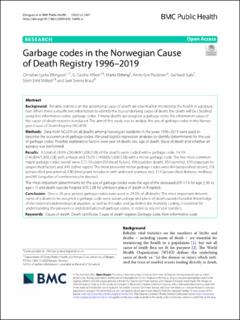| dc.description.abstract | Background
Reliable statistics on the underlying cause of death are essential for monitoring the health in a population. When there is insufficient information to identify the true underlying cause of death, the death will be classified using less informative codes, garbage codes. If many deaths are assigned a garbage code, the information value of the cause-of-death statistics is reduced. The aim of this study was to analyse the use of garbage codes in the Norwegian Cause of Death Registry (NCoDR).
Methods
Data from NCoDR on all deaths among Norwegian residents in the years 1996–2019 were used to describe the occurrence of garbage codes. We used logistic regression analyses to identify determinants for the use of garbage codes. Possible explanatory factors were year of death, sex, age of death, place of death and whether an autopsy was performed.
Results
A total of 29.0% (290,469/1,000,128) of the deaths were coded with a garbage code; 14.1% (140,804/1,000,128) with a major and 15.0% (149,665/1,000,128) with a minor garbage code. The five most common major garbage codes overall were ICD-10 codes I50 (heart failure), R96 (sudden death), R54 (senility), X59 (exposure to unspecified factor), and A41 (other sepsis). The most prevalent minor garbage codes were I64 (unspecified stroke), J18 (unspecified pneumonia), C80 (malignant neoplasm with unknown primary site), E14 (unspecified diabetes mellitus), and I69 (sequelae of cerebrovascular disease).
The most important determinants for the use of garbage codes were the age of the deceased (OR 17.4 for age ≥ 90 vs age < 1) and death outside hospital (OR 2.08 for unknown place of death vs hospital).
Conclusion
Over a 24-year period, garbage codes were used in 29.0% of all deaths. The most important determinants of a death to be assigned a garbage code were advanced age and place of death outside hospital. Knowledge of the national epidemiological situation, as well as the rules and guidelines for mortality coding, is essential for understanding the prevalence and distribution of garbage codes, in order to rely on vital statistics. | en_US |

